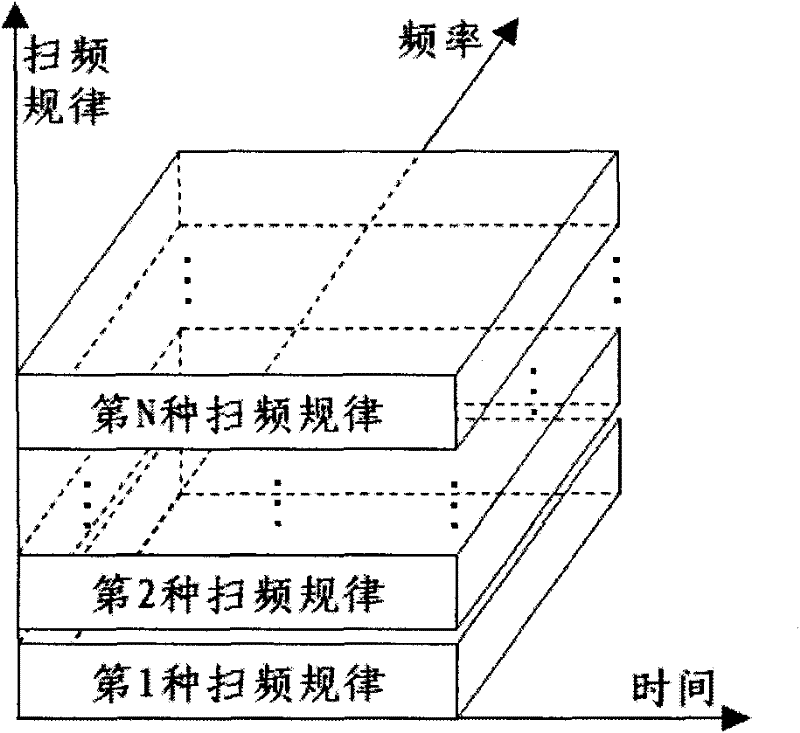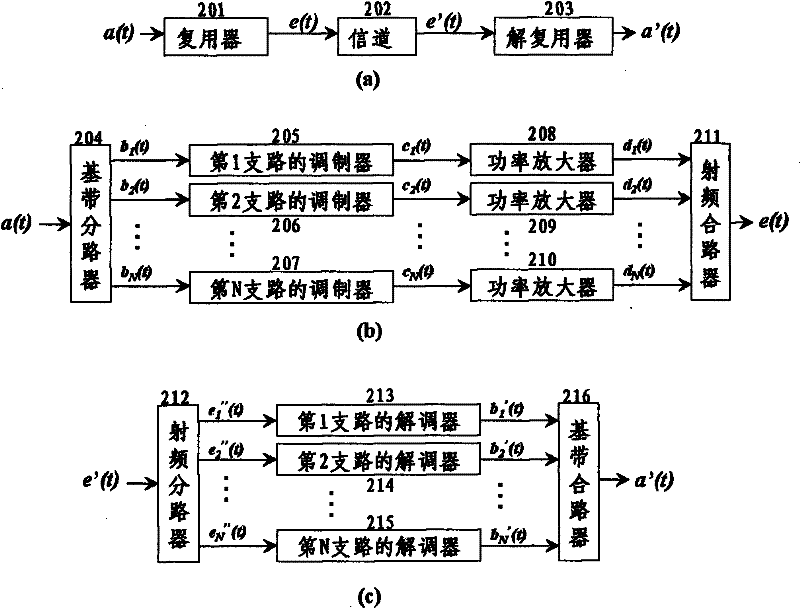A fm/chirp waveform segmentation multiplex communication method and its application system
A waveform segmentation and multi-channel communication technology, applied in the field of communication, can solve the problem that Chirp pulse carrier is not used for multi-channel communication
- Summary
- Abstract
- Description
- Claims
- Application Information
AI Technical Summary
Problems solved by technology
Method used
Image
Examples
Embodiment 1
[0131] This embodiment is used to illustrate the working process of a FM / Chirp waveform division multiplexing communication system used in the downlink channel between the base station and the mobile station, and its system structure is as follows Figure 9 shown.
[0132] In the downlink transmission part (901) of the base station, a baseband total signal a(t) to be transmitted is decomposed into two branches of the baseband sub-signal b to be transmitted through the baseband splitter (908) i (t)(1≤i≤2); In the first branch, the baseband sub-signal b to be transmitted will be transmitted according to the FM / Chirp composite frequency modulation method 1 (t) sent to the modulator (909) of the first branch for carrier modulation to generate the modulated carrier c of the first branch 1 (t), the modulated carrier c 1 (t) output to the resonant power amplifier (911); the output d of the resonant power amplifier (911) 1 (t) As one output of the downlink transmitting part (901) o...
Embodiment 2
[0141] This embodiment is used to illustrate the working process of an uplink FM / Chirp waveform division multiple access communication system that realizes co-frequency coverage in two base stations. Taking the situation where there are 2 base stations and each base station has a corresponding mobile station as an example, the system structure is as follows Figure 10 shown.
[0142] In the transmitting part (1001) of mobile station A, baseband signal b to be transmitted A (t) carry out carrier modulation by FM / Chirp modulator (1013), the modulated carrier c of its output A (t) as the input of the resonant power amplifier (1014); the output d of the resonant power amplifier (1014) A (t) Input to wireless channel (1009) and wireless channel (1012) through transmit antenna (1003). Similarly, in the transmitting part (1002) of the mobile station B, the baseband signal b to be transmitted is B (t) carry out carrier modulation by FM / Chirp modulator (1013), the modulated carrier...
Embodiment 3
[0153] This embodiment is used to illustrate the working process of an uplink TDMA / FCWDMA system that realizes co-frequency coverage in two base stations. Taking the situation where there are 2 base stations and each base station has 2 corresponding mobile stations as an example, the system structure is as follows Figure 11 shown. Figure 11 The mobile station A1 transmitting part (1101), the mobile station A2 transmitting part (1107), the mobile station B1 transmitting part (1103) and the mobile station B2 transmitting part (1109) shown in Figure 6 Shown in (b); The composition structure of base station A receiving part (1105) and base station B receiving part (1111) is as follows Figure 6 (c) shown.
[0154] Figure 11 All the transmitting antennas, all the receiving antennas and the wireless channels between all the antennas form a wireless channel such as Figure 7 The passive MIMO channel shown; wherein, the receiving antenna (1106) is equivalent to the channel com...
PUM
 Login to View More
Login to View More Abstract
Description
Claims
Application Information
 Login to View More
Login to View More - R&D
- Intellectual Property
- Life Sciences
- Materials
- Tech Scout
- Unparalleled Data Quality
- Higher Quality Content
- 60% Fewer Hallucinations
Browse by: Latest US Patents, China's latest patents, Technical Efficacy Thesaurus, Application Domain, Technology Topic, Popular Technical Reports.
© 2025 PatSnap. All rights reserved.Legal|Privacy policy|Modern Slavery Act Transparency Statement|Sitemap|About US| Contact US: help@patsnap.com



